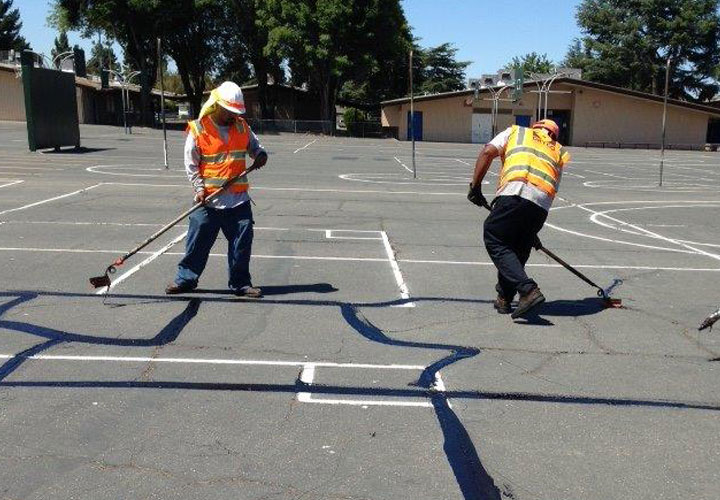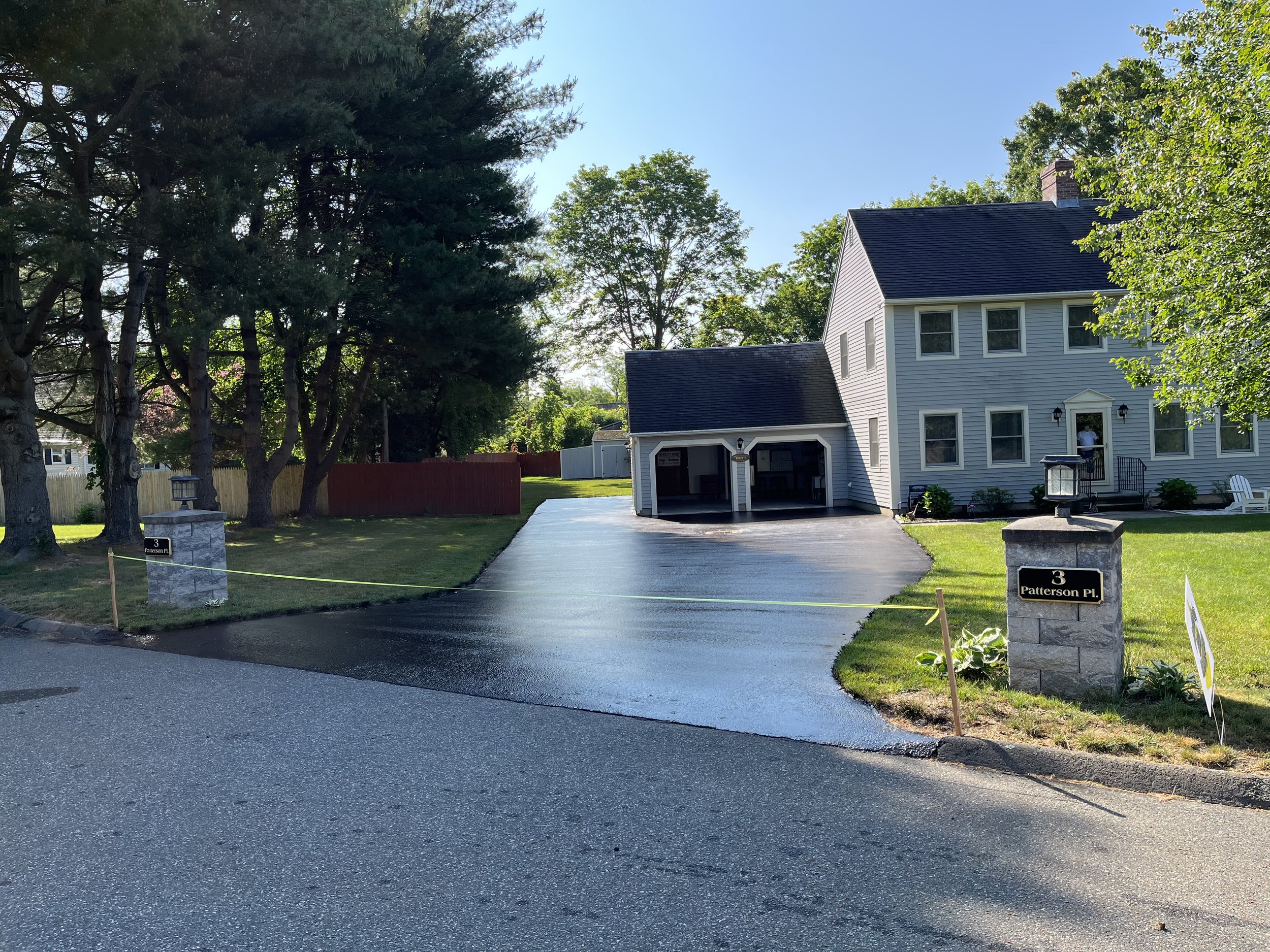Discover the Power of Business Parking Lot Leading and Asphalt Sealing
Wiki Article
Warm Mix Asphalt: A Lasting Service for Pavement
Hot Mix Asphalt (HMA) has actually arised as a leading lasting choice for sidewalk options, supplying a myriad of environmental advantages and ingenious technologies. Its capability to reuse materials and decrease energy usage presents an engaging situation for its fostering in road building jobs. The lasting performance and toughness of HMA make it a recommended alternative for infrastructure growth. As the need for environment-friendly building methods grows, checking out the nuances of HMA's sustainability can offer beneficial understandings right into the future of pavement options.Environmental Benefits of Warm Mix Asphalt

Additionally, Hot Mix Asphalt assists to alleviate urban warm island effects. Its dark shade soaks up sunshine, reducing the amount of warm mirrored back right into the atmosphere compared to lighter-colored sidewalks. This can decrease ambient temperatures in urban locations, lowering the demand for a/c and ultimately lowering energy consumption.
Furthermore, Hot Mix Asphalt contributes to improved stormwater monitoring. Its permeable nature allows water to recharge and infiltrate the pavement groundwater supplies, decreasing runoff and the risk of flooding. These environmental benefits make Warm Mix Asphalt a lasting option for paving freeways and roadways.
Energy Effectiveness in HMA Manufacturing
Is energy effectiveness a vital variable in the production of Hot Mix Asphalt (HMA)? Energy plays a considerable duty in the production of HMA, impacting both price and ecological sustainability. One crucial aspect of power efficiency in HMA production is the use of warm mix asphalt (WMA) innovations.Additionally, developments in plant technologies have resulted in even more energy-efficient HMA manufacturing processes. Modern plants are designed with functions like recycled asphalt pavement (RAP) processing capabilities, effective heater systems, and improved insulation, all adding to energy financial savings. By enhancing energy usage in HMA production, the market can decrease its carbon footprint while keeping premium pavement products. Power efficiency is, as a result, an important consideration in making certain the sustainability of Hot Mix Asphalt manufacturing.
Recyclability of Warm Mix Asphalt
The recyclability of Hot Mix Asphalt (HMA) is a crucial element of its sustainability and long-term environmental effect. HMA is among the most recycled materials in the United States, with over 100 million heaps of redeemed asphalt pavement (RAP) being recycled yearly in brand-new pavement building and construction. Recycling HMA provides numerous environmental advantages, such as lowering the requirement for virgin materials, lowering energy intake during production, and lowering the amount of waste sent out to land fills.The process of reusing HMA involves crushing the existing sidewalk, crushing it into smaller sized items, and blending it with brand-new aggregate and asphalt binder to produce a recycled mix. This recycled mix can commonly carry out as well as and even far better than conventional HMA, while calling for fewer raw materials and producing reduced greenhouse gas discharges. By including RAP into new sidewalk projects, roadway firms can save natural deposits, reduce expenses, and decrease the ecological footprint of roadway building and construction and maintenance tasks. Generally, the recyclability of HMA plays a considerable role in promoting sustainable practices within the pavement sector.

Long-Term Performance of HMA
Asphalt sidewalks demonstrate durability and strength over an extensive duration, showing the long-lasting efficiency of Hot Mix Asphalt (HMA) Additionally, improvements in HMA modern technology, such as the usage of polymer-modified binders and warm mix asphalt, have actually better improved the durability and longevity of HMA pavements. By focusing on high quality construction and upkeep techniques, HMA continues to confirm itself as a cost-efficient and sustainable service for durable pavement infrastructure.
HMA: Longevity and Sustainability
Showing both resilience and sustainability, Warm Mix Asphalt (HMA) has actually come to be a cornerstone in the building and construction of long-lasting sidewalk frameworks - angled parking. HMA's toughness stems from its capacity to stand up to hefty lots, harsh climate condition, and high website traffic volumes, making it a trustworthy selection for highways, highways, and airport paths. The composition of HMA, which normally includes accumulations, binder, and filler, plays an essential role in improving its durability and resistance to tear and use
Furthermore, HMA's sustainability depends on its recyclability and energy-efficient production process. The capability to reuse recovered asphalt pavement (RAP) in new HMA mixes reduces the need for virgin products and minimizes the environmental impact of sidewalk building and maintenance. Furthermore, the power performance of producing HMA hinges on its reduced blending temperature levels contrasted to various other pavement materials, bring about reduced energy consumption and greenhouse gas discharges.
Final Thought
In final thought, hot mix asphalt (HMA) uses a lasting option for sidewalk with its ecologically pleasant qualities. HMA's recyclability, energy efficiency in manufacturing, and lasting longevity make it an eco-friendly selection for road construction. By preserving all-natural sources, decreasing waste, and lowering greenhouse gas exhausts, HMA plays a vital role in advertising sustainability in facilities advancement. Its capability to minimize city warm island results even more emphasizes its significance in producing eco mindful and resistant sidewalk systems.
HMA is one of the most recycled materials in the United States, with over 100 million heaps of recovered asphalt pavement (RAP) being reused annually in new sidewalk building.The procedure of reusing HMA entails milling the existing pavement, crushing it right into smaller sized items, and mixing it with brand-new accumulation and asphalt binder to develop a recycled mix.Asphalt sidewalks demonstrate durability and strength over an extensive period, mirroring the long-lasting performance of Hot Mix Asphalt (HMA) Additionally, advancements in HMA modern technology, such as the use of polymer-modified binders and warm mix asphalt, have actually even more boosted the sturdiness commercial parking lot paving and long life of HMA sidewalks. The ability to recycle recovered asphalt pavement (RAP) in brand-new HMA mixes lowers the demand for virgin materials and decreases the ecological influence of pavement building and construction and upkeep.
Report this wiki page